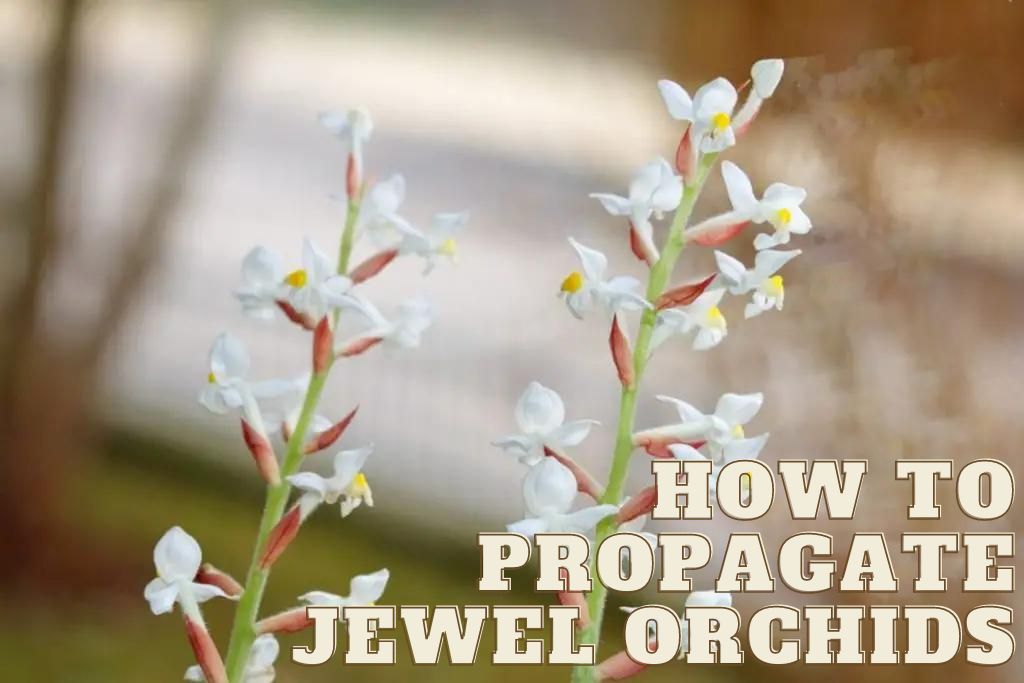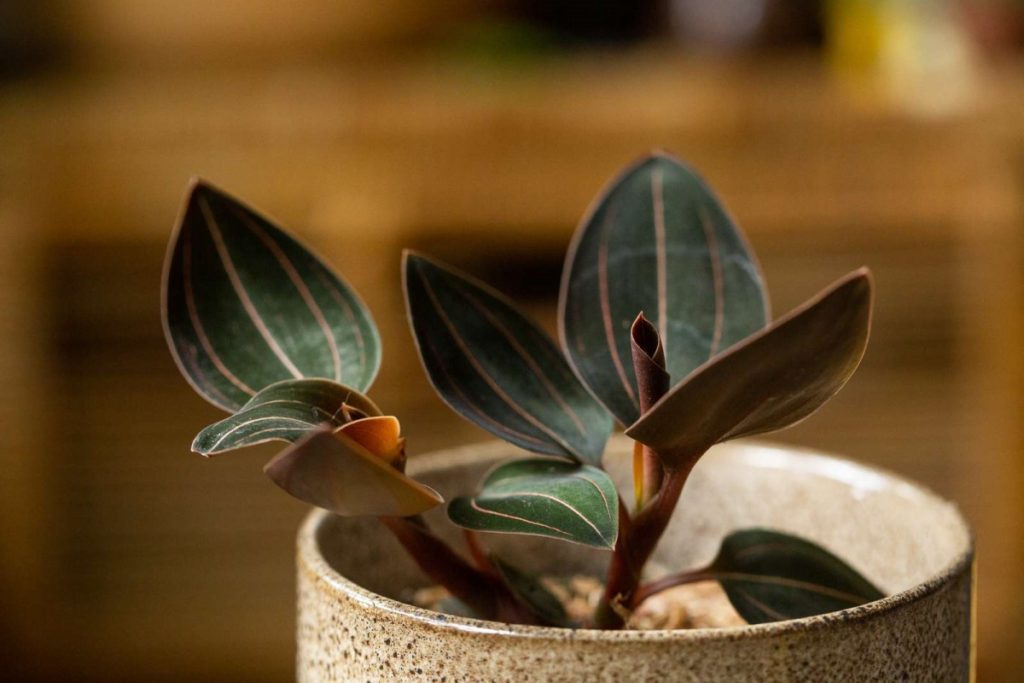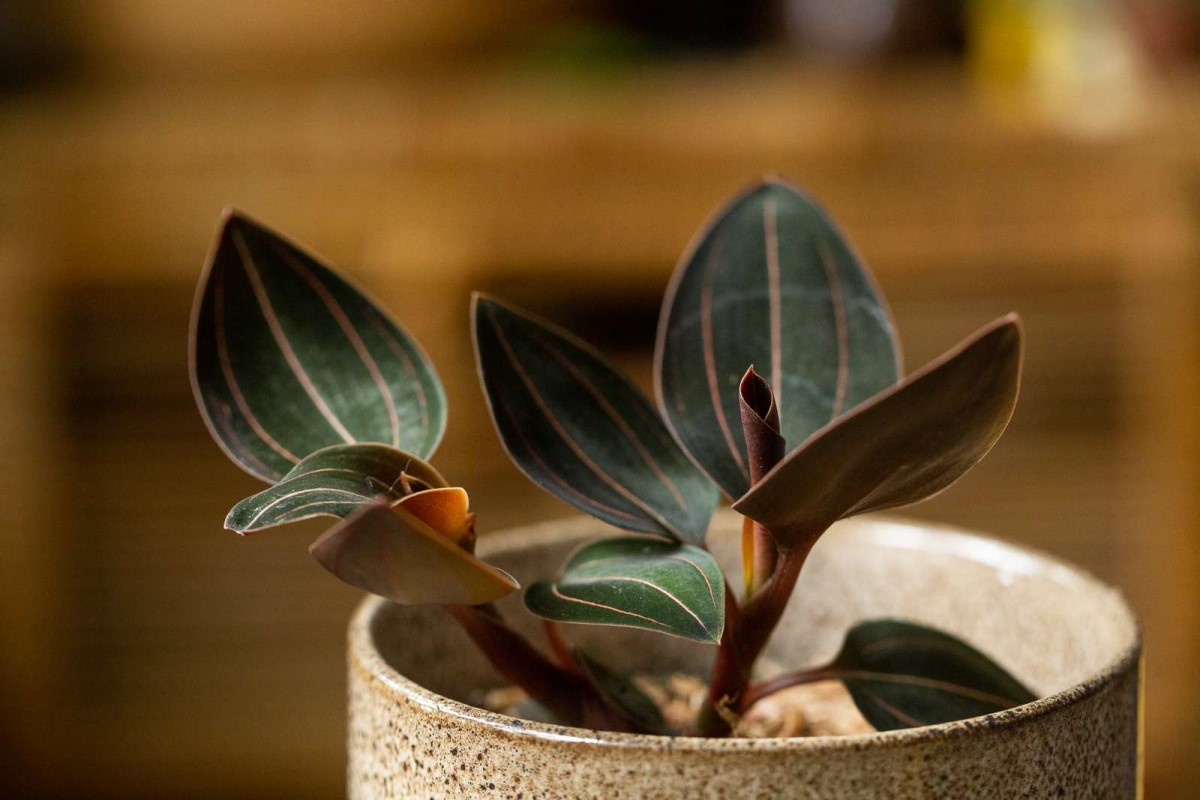This flower is unique. It is exotic but easy to care for. Therefore, it is suitable for both beginners and experienced flower growers. What do we know about it? How to propagate the jewel orchids?

How to propagate jewel orchids? Brief description of the jewel orchid flowers
Ludisia discolor is the “precious” orchid. Occurring names: Ludisia, Gemaria. Compared to other species, its flowers are not as showy. It is valued for its chic foliage.
Black jewel orchid
The black jewel orchid (Ludisia discolor) is a popular species of orchid that is prized for its velvety black leaves with striking white veins. Unlike many other orchids, the black jewel orchid is primarily grown for its foliage rather than its flowers, which are small and insignificant.
Black jewel orchids are relatively easy to care for, but they do have specific requirements to keep them healthy and looking their best. Here are some tips for growing a black jewel orchid:
- Light: Black jewel orchids prefer bright, indirect light. Avoid direct sunlight, which can scorch the leaves.
- Watering: These plants prefer moist, but not waterlogged soil. Water when the top inch of soil feels dry to the touch.
- Humidity: Black jewel orchids prefer high humidity levels, so it’s a good idea to mist the plant regularly or place it on a tray of pebbles filled with water.
- Temperature: These orchids prefer temperatures between 60-80°F, so avoid exposing them to extreme temperatures.
- Fertilizer: Use a balanced fertilizer every 2-4 weeks during the growing season (spring and summer).
- Repotting: Black jewel orchids can become root-bound, so it’s a good idea to repot them every 1-2 years.
With proper care, a black jewel orchid can be a beautiful addition to any indoor plant collection.
The geography of the flower jewel orchids is extensive: Vietnam, New Guinea, and Zealand. The deciduous form is in Brazil and Vietnam. Cold-resistant Ludisia discolor is in Japan, China, and India. Simple ludisia orchids are in Russia.

Differences
A herbaceous bicolor plant with its roots attached to moss in trees or caves. Its size is no more than 15 cm. The stems are thick, creeping.
The green leaves are sparkling, velvety, with silvery strokes. The green leaves also may be dark green, brown, purple, or red shade. Sometimes stunning foliage, maybe even black. Therefore, a ludisia orchid is also called “variegated”. Beautiful blooms are all year round, retaining their decorative effect for up to 7 years. The peduncle is high. Throws out small fragrant white flowers.

How do jewel orchids reproduce?
Stem cutting
Jewel orchids can be propagated all year round by stem cuttings. However, in the spring-summer period, the engraftment of young shoots is faster and easier. The upper part of the stem, where 2-3 nodes are left, is cut off. Cauterize the cut with brilliant green or coal.
The stalk is placed in wet sphagnum moss, placing leaves on its surface. Water with charcoal will also be good. In a young plant, flower stalks are first removed for better growth.

The division of the bush
How do you divide jewel orchids? When transplanting, the tropical plants are divided into 2-3 parts, carefully dividing the roots. Each specimen must have at least 3 stems.
Apical stem segments
The tops of the stems with two nodes are cut off and rooted in water or wet sphagnum.

Can you propagate jewel orchids in waer?
Yes, some gardeners, place the stalk in a glass of water. After 10-14 days, roots appear. All jewel orchid roots are fluffy. How long does it take a jewel orchid to root? New roots should develop within a month or two.
Jewel orchid care
Of all the “precious” orchids, the jewel orchid is the most adapted to room conditions, and easy to care for.

Lighting
Since this is a cold-loving plant, jewel orchid need to be in partial shade. Optimal: southeast, southwest, or north-facing window. If you place it in the south, provide diffused light in the summer. If in the north – artificial lighting in the winter months.
Access to uniform soft light must be 12-15 hours/day. With insufficient quantity, the stems begin to stretch.
Placement near the heating battery is excluded. Direct sunlight should be avoided. Because direct sunlight may burn the leaves.

Temperature, humidity
In the heat, the maximum temperature is +77ºF during the day, and +68ºF – at night. In winter, it may be slightly lower. Provide a contrast difference in daily temperatures – up to 50ºF. This promotes lush flowering. Drafts should be avoided. Micro-ventilation is acceptable.
High humidity should be maintained – 70-75%. With its insufficiency, the air around the jewel orchid is often sprayed, especially in summer. Or put pallets with water nearby. Otherwise, infection with various jewel orchid problems is possible: whitefly, spider web, mealybug, scale insect.

Watering. Why does root rot happen?
Water for irrigation of jewel orchid is taken soft, slightly warmer than room temperature for potting soil. Distilled and boiled water is also suitable. Morning or afternoon watering of the substrate is carried out. If all the parameters are perfectly matched, then most orchids need one watering per week.

You can not do this from above so that the axils of the leaves are not filled with moisture. Since it stagnates there, which leads to root rot, and possibly the death of the jewel orchid. All water should drain into the pan. And it is better to arrange a “bath” in the shower.
The criterion for ideal watering is light soil moisture. Over drying is also excluded.
Top dressing
Feeding jewel orchids is rarely necessary: approximately 2-4 times in half a year. Store-bought concentrate for growing jewel orchid is used according to the instructions.
Dormant period
Flowering is observed mainly in autumn: October-November, in spring: early March. Possibly in winter – December. After active growth, a dormant period may occur. But, as mentioned, the jewel orchid care is modest. Therefore, if you want constant flowering, provide her with cooler conditions at this time – up to +65ºF.
Transfer
It is produced in the spring once every 1-2 years. A wide, low pallet with holes will be convenient for such a jewel orchid. Surprisingly, this beauty can grow in one sphagnum. But then it will require more complex care.

Therefore, for jewel orchid care it is better to take a classic fresh potting mix, with a slightly larger amount of moss. It must be present on the surface of the soil. It is pre-soaked for 1-2 hours in room water to remove insects.
You can use also such kinds of potting soil recipes: 4 parts of red peat + 4 parts of humus + 4 parts of fresh moss + 4 parts of pine green needles + 1 part of birch charcoal + 1 part of orchid bark.
After transplantation, the jewel orchid is provided with light, heat, and moisture. A sharp temperature drop is not yet desirable.
Diseases and pests
The plant is susceptible to mealybugs, spider mites, scale insects, and whiteflies. All this can happen due to dry air and lack of moisture.
But if you often over-moisten the jewel orchid, this can lead to rot. Burns on the leaves are from the scorching sun, for the same reason the jewel orchid may wither.
Read also: how to repot orchids with air roots: a step-by-step guide, useful advice.
Kinds
In nature, the jewel orchid is of only one type – two-color. There are names colorless or multicolored.
However, there are various forms of the plant: Alda, Davsoniana, Odina, Velvet (Green Velvet, Red, Silver, Emerald, etc.)

Dawsoniana is one of the largest forms, about 30 cm high. The leaves are red-brown, with pinkish veins.
Odina – has dark green or black leaves with silvery stripes.

Velvet – the names of this variety are given by the color of the foliage. It is velvet with a contrasting pattern.
Conclusion
As you can see, Ludisia discolor is a fairly rare houseplant. But if you saw such a beautiful flower while walking in a flower shop, you need to buy it for your home. After all, as you can see in the photo, even the simple beautiful foliage of the plant is simply gorgeous.

In addition, you can easily transplant the plant at home and create a whole home garden with beautiful plants. Jewel orchid care is not very difficult, so it will not take you much time. For the orchid to bloom beautifully and delight you with its foliage, you need proper watering and moisturizing.
Make sure that the sunlight in the window is not too scorching. For many plants, including an orchid, this will be disastrous.
Conclusion
Jewel orchids are unique and beautiful plants that are prized for their striking foliage, rather than their flowers. These plants are known for their velvety leaves with intricate patterns of silver, gold, and maroon that resemble gemstones. Although jewel orchids are relatively easy to care for, they can still encounter a few issues. Here are some of the most common issues with jewel orchids:
- Overwatering: Jewel orchid prefers moist but well-draining soil, and they are susceptible to root rot if they are overwatered. It is important to allow the top inch of soil to dry out before watering again.
- Underwatering: On the other hand, jewel orchids should not be allowed to dry out completely between waterings. If the leaves become wrinkled or droopy, it may be a sign that the plant is not getting enough water.
- Lack of humidity: Jewel orchid prefers high humidity levels, and they may struggle in dry environments. To increase humidity, place the plant on a tray of pebbles filled with water or use a humidifier.
- Insufficient light: Jewel orchids need bright, indirect light to thrive. If they are not getting enough light, their leaves may lose their color and become less vibrant.
- Pests: Jewel orchids can be susceptible to pests such as spider mites, mealybugs, and scale insects. Regularly inspect the plant for signs of infestation and treat with an appropriate insecticide if necessary.
- Temperature extremes: Jewel orchids are tropical plants and prefer temperatures between 60-85°F. They may struggle if exposed to extreme temperatures or drafts.
By providing the right conditions, such as appropriate watering, lighting, and humidity levels, you can help your jewel orchid thrive and avoid these common issues.
Can you grow jewel orchids from cuttings?
No, jewel orchids (Ludisia discolor) typically cannot be propagated by cuttings and must be propagated by division of the parent plant or by growing new plants from the rhizomes.
Can I root jewel orchid in water?
No, jewel orchids (Ludisia discolor) cannot be rooted in water. They require a well-draining potting mix to grow and cannot survive in standing water.
How do I make my jewel orchid bushy?
1. Repot the plant in a slightly larger pot with fresh, well-draining potting mix.
2. Trim the leaves and roots as needed to encourage new growth.
3. Provide bright, indirect light and maintain a consistent temperature.
4. Fertilize regularly with an orchid fertilizer to promote healthy growth.
5. Divide the plant when it becomes too large or when new growth appears.

